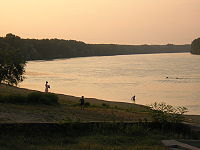
Belene Island
Encyclopedia


Island
An island or isle is any piece of sub-continental land that is surrounded by water. Very small islands such as emergent land features on atolls can be called islets, cays or keys. An island in a river or lake may be called an eyot , or holm...
in Bulgaria
Bulgaria
Bulgaria , officially the Republic of Bulgaria , is a parliamentary democracy within a unitary constitutional republic in Southeast Europe. The country borders Romania to the north, Serbia and Macedonia to the west, Greece and Turkey to the south, as well as the Black Sea to the east...
n waters. The island is formed by the Danube River splitting into two branches passing north and south of it. The international frontier between Bulgaria and Romania
Romania
Romania is a country located at the crossroads of Central and Southeastern Europe, on the Lower Danube, within and outside the Carpathian arch, bordering on the Black Sea...
follows the north branch of the river and therefore Belene Island is part of the Bulgarian territory. The island is 14.5 kilometres (9 mi) long and reaching 6 km (3.7 mi) in width; it is located in the Danube, north of the town of Belene
Belene
Belene is a town in Pleven Province, Northern Bulgaria. It is the administrative centre of the homonymous Belene Municipality. The town is situated on the right bank of the Danube river, close to the town of Svishtov...
. Belene Island is the fourth biggest Danube island: during an average tide it is 41.078 square kilometres (15.9 sq mi) in area. During a high tide, parts of the island are submerged.
Belene Island is a part of the Belene Islands Complex and of the Persina Natural Park, a home to over 170 species of rare water bird
Bird
Birds are feathered, winged, bipedal, endothermic , egg-laying, vertebrate animals. Around 10,000 living species and 188 families makes them the most speciose class of tetrapod vertebrates. They inhabit ecosystems across the globe, from the Arctic to the Antarctic. Extant birds range in size from...
s, such as the Glossy Ibis
Glossy Ibis
The Glossy Ibis is a wading bird in the ibis family Threskiornithidae.This is the most widespread ibis species, breeding in scattered sites in warm regions of Europe, Asia, Africa, Australia, and the Atlantic and Caribbean region of the Americas...
, Pygmy Cormorant
Pygmy Cormorant
The Pygmy Cormorant is a member of the cormorant family of seabirds. It breeds in southeastern Europe and southwestern Asia. It is partially migratory, with northern populations wintering further south, mostly within in its breeding range...
, Lesser Grey Shrike
Lesser Grey Shrike
The Lesser Grey Shrike is a member of the shrike family Laniidae.It is similar in appearance to the Great Grey Shrike Lanius excubitor and the Southern Grey Shrike L. meridionalis...
, Red-breasted Goose
Red-breasted Goose
The Red-breasted Goose is an endangered species of goose in the genus Branta. It is sometimes separated in Rufibrenta but appears close enough to the Brent Goose to make this unnecessary, despite its distinct appearance.- Description :All the species of the Branta genus are distinguished by their...
and others. The flora
Flora
Flora is the plant life occurring in a particular region or time, generally the naturally occurring or indigenous—native plant life. The corresponding term for animals is fauna.-Etymology:...
of Belene Island is represented by willow
Willow
Willows, sallows, and osiers form the genus Salix, around 400 species of deciduous trees and shrubs, found primarily on moist soils in cold and temperate regions of the Northern Hemisphere...
s, poplar
Poplar
Populus is a genus of 25–35 species of deciduous flowering plants in the family Salicaceae, native to most of the Northern Hemisphere. English names variously applied to different species include poplar , aspen, and cottonwood....
s and asp
Aspen
Populus section Populus, of the Populus genus, includes the aspen trees and the white poplar Populus alba. The five typical aspens are all native to cold regions with cool summers, in the north of the Northern Hemisphere, extending south at high altitudes in the mountains. The White Poplar, by...
s; there is some arable land
Arable land
In geography and agriculture, arable land is land that can be used for growing crops. It includes all land under temporary crops , temporary meadows for mowing or pasture, land under market and kitchen gardens and land temporarily fallow...
. The island was formed of alluvial sediment
Sediment
Sediment is naturally occurring material that is broken down by processes of weathering and erosion, and is subsequently transported by the action of fluids such as wind, water, or ice, and/or by the force of gravity acting on the particle itself....
s.
The island is infamous for the Belene concentration camp that functioned there for detention of political prisoners between 1949–1953 and 1956–1959. The Belene Prison is still operating as a penitentiary in the western part of the island, while the eastern part is a managed natural reserve.

